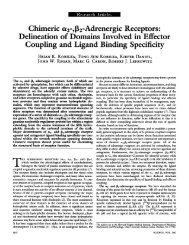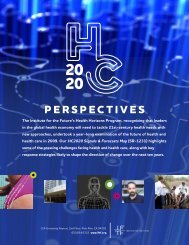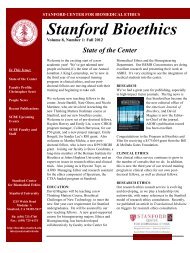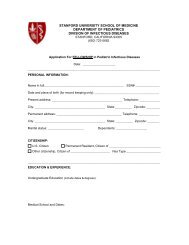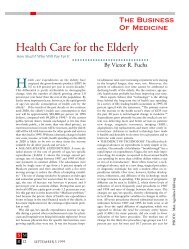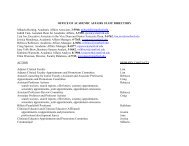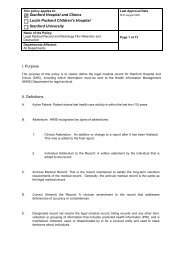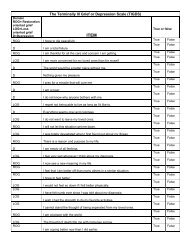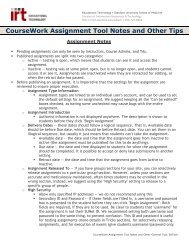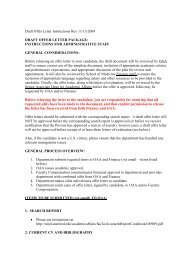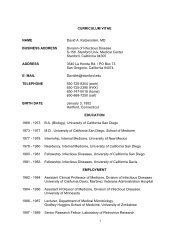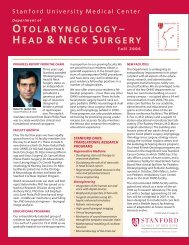Funds Flow Model - Stanford University School of Medicine
Funds Flow Model - Stanford University School of Medicine
Funds Flow Model - Stanford University School of Medicine
Create successful ePaper yourself
Turn your PDF publications into a flip-book with our unique Google optimized e-Paper software.
<strong>Funds</strong> <strong>Flow</strong> <strong>Model</strong><br />
<strong>Stanford</strong> Hospital & Clinics<br />
DFA Meeting<br />
February 14, 2005
<strong>Funds</strong> <strong>Flow</strong> <strong>Model</strong><br />
Purpose <strong>of</strong> Briefing<br />
We intend to reinvent the funds flow<br />
to better align SHC and the SoM into<br />
a more integrated and functional<br />
organization
<strong>Funds</strong> <strong>Flow</strong> <strong>Model</strong><br />
Team Members<br />
The <strong>Funds</strong> <strong>Flow</strong> Working Group formed in September,<br />
2004, with the following membership:<br />
Marcia J. Cohen David R. Kiehn<br />
Michael A. Hindery Norman W. Rizk, M.D.<br />
Robert Jackler, M.D. Gerald M. Shefren, M.D.<br />
In January, 2005, the Group expanded to receive input from<br />
additional Department Chairs:<br />
Thomas M. Krummel, M.D. William J. Maloney, M.D.<br />
Alfred T. Lane, M.D. Ronald Pearl, M.D.
Current <strong>Flow</strong> <strong>of</strong> <strong>Funds</strong> from<br />
SHC to SoM Depts (FY2004)<br />
Components<br />
1. Pr<strong>of</strong>essional Services Agreement (PSA) -<br />
Collections from billing net <strong>of</strong> direct operating<br />
expense and allocated “shared expenses” ($90M)<br />
2. Other payments for services ($27M)<br />
• Medical direction<br />
• Essential services<br />
• Program development<br />
• Reimbursement for SoM clinical staff and services provided<br />
to the SHC<br />
3. Service Incentives & Practice Deficit Support ($3.5M)<br />
4. “Grants” ($13M)
Pr<strong>of</strong>essional Services Agreement (PSA)<br />
<strong>Funds</strong> <strong>Flow</strong><br />
Academic Grants<br />
<strong>Stanford</strong> Hospital & Clinics<br />
Physician Pr<strong>of</strong>essional Fees<br />
Gross Charges<br />
− Contractual Adjustments<br />
= Net Collections & Other Rev<br />
− Ambulatory Clinic Direct Expenses<br />
− Shared Expense Allocations:<br />
Finance & Admin<br />
Space<br />
Information Systems<br />
Pr<strong>of</strong>essional Malpractice<br />
Billing Expense<br />
+ Adjustments<br />
= PSA Payment<br />
Service Agreements<br />
+ Medical Direction<br />
+ Hospital Essential Services<br />
+ Fellows<br />
+ Purchased Services<br />
+ Program Development<br />
= Service Payments<br />
+ Service Incentives<br />
+ Deficit Support<br />
Academic Grants<br />
+ Overall Academic Grant<br />
+ Ambulatory Academic Grant<br />
= Academic Grants<br />
Current <strong>Funds</strong> <strong>Flow</strong><br />
<strong>Stanford</strong> <strong>University</strong> Clinical Depts<br />
PSA Payment<br />
Service Payments<br />
Academic Grant Distribution<br />
= Total Clinical Revenue<br />
− Deans Tax<br />
− Expenses:<br />
−Faculty/Physician Compensation<br />
−Benefits<br />
−Dept Clinical Management and Staff<br />
−Dept Clinical Supplies and Equipment<br />
Dept Clinical Pr<strong>of</strong>it or Loss<br />
+ Service Incentives & Deficit Support<br />
Amount Available for Department<br />
Initiatives and Faculty/Physician Bonuses<br />
<strong>Stanford</strong> <strong>University</strong> <strong>School</strong> <strong>of</strong> <strong>Medicine</strong><br />
Academic Grants<br />
Deans Tax<br />
− Deficit Support<br />
−Service Incentives<br />
Amount Available for <strong>School</strong> Initiatives
Pr<strong>of</strong>essional Services Agreement (PSA)<br />
<strong>Funds</strong> <strong>Flow</strong><br />
Academic Grants<br />
<strong>Stanford</strong> Hospital & Clinics<br />
Physician Pr<strong>of</strong>essional Fees<br />
Gross Charges<br />
− Contractual Adjustments<br />
= Net Collections & Other Rev<br />
− Ambulatory Clinic Direct Exp<br />
− Shared Expense Allocations:<br />
Finance & Admin<br />
Space<br />
Information Systems<br />
Pr<strong>of</strong>essional Malpractice<br />
Billing Expense<br />
+ Adjustments<br />
= PSA Payment<br />
Service Agreements<br />
+ Medical Direction<br />
+ Hospital Essential Services<br />
+ Fellows<br />
+ Purchased Services<br />
+ Program Development<br />
= Service Payments<br />
+ Service Incentives<br />
+ Deficit Support<br />
Academic Grants<br />
+ Overall Academic Grant<br />
+ Ambulatory Academic Grant<br />
=Academic Grants<br />
Current <strong>Funds</strong> <strong>Flow</strong><br />
$357.0m<br />
$140.9m<br />
($37.0m)<br />
($19.6m)<br />
$5.8m<br />
$90.1m<br />
$27.2m<br />
($3.4m)<br />
$12.5m<br />
FY 2004 Operating Results<br />
<strong>Stanford</strong> <strong>University</strong> Clinical Depts<br />
PSA Payment<br />
Service Payments<br />
Academic Grant Distribution<br />
= Total Clinical Revenue<br />
− Deans Tax<br />
− Expenses:<br />
($112.8m)<br />
−Faculty/Physician Compensation<br />
−Benefits<br />
−Dept Clinical Management and Staff<br />
−Dept Clinical Supplies and Equipment<br />
Dept Clinical Pr<strong>of</strong>it or Loss $9.0m<br />
+ Service Incentives & Deficit Support<br />
Amount Available for Department $16.3m<br />
Initiatives and Faculty/Physician Bonuses<br />
<strong>Stanford</strong> <strong>University</strong> <strong>School</strong> <strong>of</strong> <strong>Medicine</strong><br />
Academic Grants<br />
Deans Tax<br />
− Deficit Support<br />
−Service Incentives<br />
Amt Available for <strong>School</strong> Initiatives<br />
$90.1m<br />
$27.2m<br />
$12.5m<br />
$129.8m<br />
($8.0m)<br />
$12.5m<br />
$8.0m<br />
$3.9m<br />
$3.9m
<strong>Funds</strong> <strong>Flow</strong> <strong>Model</strong><br />
Case for Change<br />
Issues with Current Payments<br />
• Unlike private practice, the <strong>Stanford</strong> PSA does not provide a<br />
mechanism for ancillary revenues to supplement pr<strong>of</strong>essional<br />
revenue<br />
• Pr<strong>of</strong>essional revenue alone cannot support the high cost <strong>of</strong><br />
ambulatory expenses<br />
–Current funds flow does not uniformly compensate for this<br />
imbalance<br />
–As a consequence, Departments are unable/unwilling financially to<br />
grow unpr<strong>of</strong>itable outpatient practices even if it would be pr<strong>of</strong>itable for<br />
the overall clinical enterprise
<strong>Funds</strong> <strong>Flow</strong> <strong>Model</strong><br />
Case for Change<br />
• Current funds flow does not incent growth <strong>of</strong> services overall<br />
– Departments are rewarded for negotiating favorable “deals”, rather than<br />
for productivity, innovation or quality<br />
– Resulting “special deals” impair relationships and distract SUMC from<br />
competing successfully within the market place<br />
• For Departments, reliance on the negotiated end-<strong>of</strong>-year “grants” to<br />
achieve financial viability means there is too much unpredictability,<br />
and impairs planning<br />
– For faculty it means compensation may not be based primarily on<br />
productivity
Principles <strong>of</strong> New <strong>Funds</strong> <strong>Flow</strong><br />
<strong>Model</strong><br />
New funds flow should:<br />
• Align incentives, be simple, formula-driven, stable,<br />
predictable and transparent<br />
• Be inclusive <strong>of</strong> medical direction, essential services,<br />
program development, graduate medical education,<br />
pr<strong>of</strong>it-sharing, and mission-based funding<br />
• Support productivity and market-based compensation<br />
for physicians<br />
• Support financial sustainability for each organization
Evaluating the Outcome<br />
• Outcome should meet the needs <strong>of</strong> the<br />
physicians, departments, & institutions<br />
– Physician recruitment & retention require competitive<br />
MGMA compensation<br />
– Departments require pr<strong>of</strong>itability for academic mission<br />
– SHC needs sufficient pr<strong>of</strong>it to meet its bond<br />
covenants & capital needs<br />
– SoM needs sufficient funds for mission-based<br />
activities
Why MGMA National Median<br />
Private Practice?<br />
• National<br />
– We compete nationally for faculty (as well as locally)<br />
– Need large number <strong>of</strong> responses to control year-to-year variability<br />
– The only index with sufficient data, especially in sub specialties<br />
• Median<br />
– Reasonable starting point<br />
• Private Practice<br />
– Academic benchmarks are:<br />
• confounded by other revenue streams (research, teaching)<br />
• confounded by part time clinical FTE<br />
• academic rank<br />
• data is too sparse for consistent, reliable index<br />
– Private practice is more sensitive to our own market conditions
Examples: Market RVU Rates for<br />
Selected Subspecialties<br />
Emergency<br />
<strong>Medicine</strong><br />
Hematology<br />
Oncology<br />
Radiation<br />
Oncology<br />
General<br />
Internal<br />
<strong>Medicine</strong><br />
2004 MGMA Median<br />
Compensation $211,708 $299,319 $369,424 $154,756<br />
20004 MGMA wRVU<br />
Median 4,670 3,895 8,373 3,858<br />
2004 "Market Rate" per<br />
wRVU $45.33 $76.85 $44.12 $40.11
Proposed funds flow methodology –<br />
RVU payments<br />
• SHC would operate the inpatient and outpatient<br />
facilities, manage the revenue cycle, and pay<br />
SoM for their pr<strong>of</strong>essional services delivered<br />
– Payment would be based on US private practice<br />
compensation by specialty and clinical service, i.e.<br />
the competitive payment for RVU’s as derived from<br />
the MGMA’s database<br />
– Total payment would need to include all expenses,<br />
including benefits, departmental overhead, graduate<br />
medical education, and Dean’s tax<br />
– RVU payments would replace the previous PSA<br />
methodology
Proposed <strong>Funds</strong> <strong>Flow</strong><br />
• Payments may be reduced for certain service payments,<br />
such as:<br />
– Medical direction, program development, essential services<br />
• Pr<strong>of</strong>it-sharing methodology, based on operating margin<br />
<strong>of</strong> the hospital, would encourage attention to overall<br />
enterprise success<br />
• A grant for education and training would acknowledge<br />
these missions within the SOM
PSA<br />
Service Payments<br />
Education<br />
Pr<strong>of</strong>it Sharing<br />
<strong>Stanford</strong> Hospital & Clinics<br />
Market Based RVU Payment<br />
Benefits Factor<br />
Deans Tax<br />
GME Payment<br />
Department Expense Factor<br />
= Total Payment<br />
Service Agreements<br />
+ Medical Direction<br />
+ Hospital Essential Services<br />
+ Fellows<br />
+ Purchased Services<br />
+ Program Development<br />
= Service Payments<br />
Proposed <strong>Funds</strong> <strong>Flow</strong> RVU Benchmark <strong>Model</strong><br />
Teaching and Education Grant<br />
Pr<strong>of</strong>it Sharing TBD<br />
<strong>Stanford</strong> <strong>University</strong> Clinical Depts<br />
Total Payment<br />
Service Payments<br />
= Total Clinical Revenue<br />
− Deans Tax<br />
− Expenses:<br />
−Faculty/Physician Compensation<br />
−Benefits<br />
−Dept Clinical Management and Staff<br />
−Dept Clinical Supplies and Equipment<br />
Dept Clinical Pr<strong>of</strong>it or Loss<br />
+ Deficit Support<br />
+Pr<strong>of</strong>it Sharing TBD<br />
Amount Available for Department<br />
Initiatives and Faculty/Physician Bonuses<br />
<strong>Stanford</strong> <strong>University</strong> <strong>School</strong> <strong>of</strong> <strong>Medicine</strong><br />
Teaching and Education Grant<br />
Deans Tax<br />
− Deficit Support<br />
Amount Available for <strong>School</strong> Initiatives
<strong>Funds</strong> <strong>Flow</strong> <strong>Model</strong><br />
Benefits<br />
• Bases payment on clinical productivity, rather than on<br />
negotiated “deals”<br />
• Provides for financial predictability and stability<br />
• Aligns incentives <strong>of</strong> SHC and Faculty physicians<br />
• Provides standardization in funds flow, which will facilitate<br />
the creation <strong>of</strong> service lines, centers, and institutes<br />
• Allows outpatient practices to achieve financial viability<br />
• Provides funding for departmental practice administrative<br />
overhead<br />
• Allots resources for the education and research missions
<strong>Funds</strong> <strong>Flow</strong> <strong>Model</strong><br />
Additional Consequences and Caveats<br />
• There is limited experience with methodology among AMC’s<br />
• Financial liability for practice deficits will shift solely to SoM<br />
• Revenue cycle management will be transferred solely to SHC<br />
• New funds flow will require more financial and practice<br />
operational management by SHC, and more focus on<br />
productivity and practice development by the practices,<br />
departments, & SoM<br />
– SHC will have the financial liability for and control <strong>of</strong> practice<br />
expenses<br />
– SOM will need to change compensation plans to be<br />
compatible with the new plan<br />
• Budgeting, incentives and infrastructure will be different for both<br />
institutions
<strong>Funds</strong> <strong>Flow</strong> <strong>Model</strong><br />
Transition<br />
Principles<br />
• The transition period should maximize the value <strong>of</strong> the new<br />
system while minimizing the risks <strong>of</strong> the conversion<br />
• The transition costs should be jointly shared by SHC and<br />
SOM<br />
• The transition period should incent growth for the entire<br />
enterprise<br />
• Benefits and losses to any party should be capped during<br />
the transition on a diminishing basis<br />
• The transition period will be 2-3 years, and changes in<br />
methodology may occur during that period
<strong>Funds</strong> <strong>Flow</strong> <strong>Model</strong><br />
Timeline<br />
• Refine the current RVU data - 3/31/05<br />
– Use outside consultant help to determine accurate payable<br />
RVU production and IDX system tracking<br />
– Analyze each department accuracy for RVU methodology<br />
– Make certain our methodology is aligned with the MGMA<br />
database<br />
– Establish methods to deal with departments and services not<br />
appropriate for RVU methodology<br />
• Communication plan with stakeholders - 4/30/05
<strong>Funds</strong> <strong>Flow</strong> <strong>Model</strong><br />
Timeline<br />
• Reach agreement on methodology components - 3/31/05<br />
– Benefits<br />
– Department Overhead<br />
– Handling <strong>of</strong> Deans Tax<br />
– GME<br />
– Education / Research<br />
– Pr<strong>of</strong>it Sharing<br />
– Incentives<br />
• Establish impact to SHC, SoM, Departments - 4/15/05<br />
• Methodology Finalized - 4/30/05<br />
• Develop Transition Plan and FY 06 Budgets - 5/31/05
Conclusions<br />
• The proposed model signals a change in direction towards paying<br />
for faculty productivity as the primary metric<br />
• The proposed model has specific funding for GME, teaching, &<br />
education<br />
• Consolidation <strong>of</strong> responsibility for multiple shared areas simplifies<br />
funds flow & improves operations<br />
– Outpatient direct and indirect expense and the entire revenue cycle will<br />
be assigned to SHC<br />
– Growth in productivity will be the primary clinical responsibility <strong>of</strong><br />
departments and faculty<br />
• The new model refocuses our attention on maintaining and<br />
enlarging our market share, as well as academic missions





